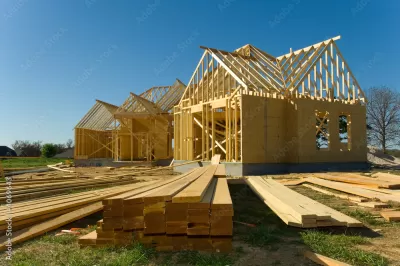U.S. homes are adding bedrooms while getting smaller, according to two seemingly contradictory articles published on the same day from different data sources earlier this month.

Contradictory conclusions about the direction of the new-build housing market circulated online on the same day this month.
On August 22, an article by Justin Fox for Bloomberg included the following data to support an article about the increasing number of bedrooms in newly constructed housing units.
Of the just over a million new single-family houses completed in the US last year, 490,000 had four or more bedrooms. That worked out to a 48% share, the highest since the US Census Bureau started keeping track in 1973—and more than double the percentage in 1973.
Another article, by Maggie Eastland for the Wall Street Journal [paywall], reported on generally shrinking footprints of new housing construction:
Since 2018, the average unit size for new housing starts has decreased 10% nationally to 2,420 square feet, according to Livabl by Zonda, a listing platform for new construction homes. Construction starts for new single-family homes declined in 2022. But starts for homes with fewer than three bedrooms increased 9.5% over the same period, according to a Zillow report.
The stories don’t totally reach opposite conclusions, however. Fox’s coverage acknowledge’s that the increase in the number of bedrooms doesn’t necessarily mean a commensurate increase in square footage:
While the median floor area of new single-family houses rose slightly in 2022, to 2,299 square feet, it’s still below pre-pandemic levels, and quarterly statistics on housing starts indicate that it will fall in 2023. But the uses to which that space is put are changing.
Further complicating any simple interpretation of the two stories are the explanations behind each of the trends reported by these two articles. Both assumptions seem reasonable: Americans want more bedrooms to facilitate working from home, according to the story about homes adding bedrooms, and less square footage is intended to lower the cost of housing, according to the story about homes decreasing in square footage.
FULL STORY: Never Mind Shrinking Households, Builders Are Adding Bedrooms

Study: Maui’s Plan to Convert Vacation Rentals to Long-Term Housing Could Cause Nearly $1 Billion Economic Loss
The plan would reduce visitor accommodation by 25,% resulting in 1,900 jobs lost.

North Texas Transit Leaders Tout Benefits of TOD for Growing Region
At a summit focused on transit-oriented development, policymakers discussed how North Texas’ expanded light rail system can serve as a tool for economic growth.

Why Should We Subsidize Public Transportation?
Many public transit agencies face financial stress due to rising costs, declining fare revenue, and declining subsidies. Transit advocates must provide a strong business case for increasing public transit funding.

How to Make US Trains Faster
Changes to boarding platforms and a switch to electric trains could improve U.S. passenger rail service without the added cost of high-speed rail.

Columbia’s Revitalized ‘Loop’ Is a Hub for Local Entrepreneurs
A focus on small businesses is helping a commercial corridor in Columbia, Missouri thrive.

Invasive Insect Threatens Minnesota’s Ash Forests
The Emerald Ash Borer is a rapidly spreading invasive pest threatening Minnesota’s ash trees, and homeowners are encouraged to plant diverse replacement species, avoid moving ash firewood, and monitor for signs of infestation.
Urban Design for Planners 1: Software Tools
This six-course series explores essential urban design concepts using open source software and equips planners with the tools they need to participate fully in the urban design process.
Planning for Universal Design
Learn the tools for implementing Universal Design in planning regulations.
City of Santa Clarita
Ascent Environmental
Institute for Housing and Urban Development Studies (IHS)
City of Grandview
Harvard GSD Executive Education
Toledo-Lucas County Plan Commissions
Salt Lake City
NYU Wagner Graduate School of Public Service




























